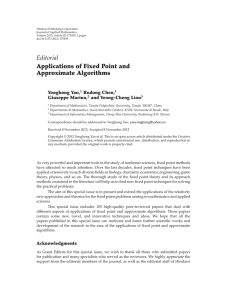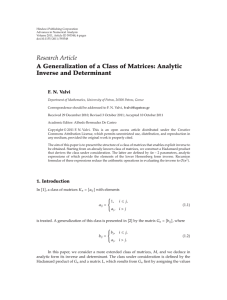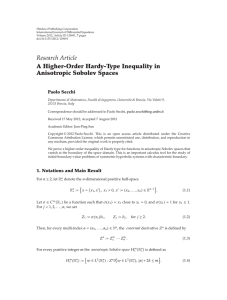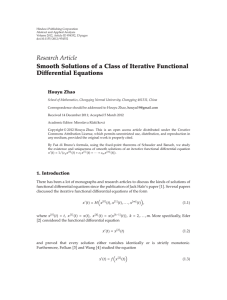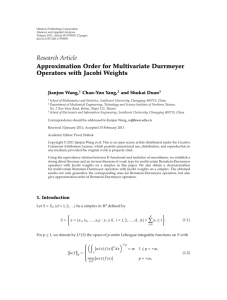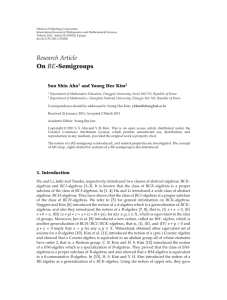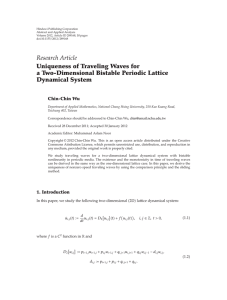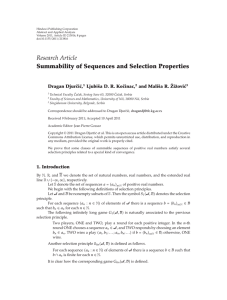Document 10821918
advertisement
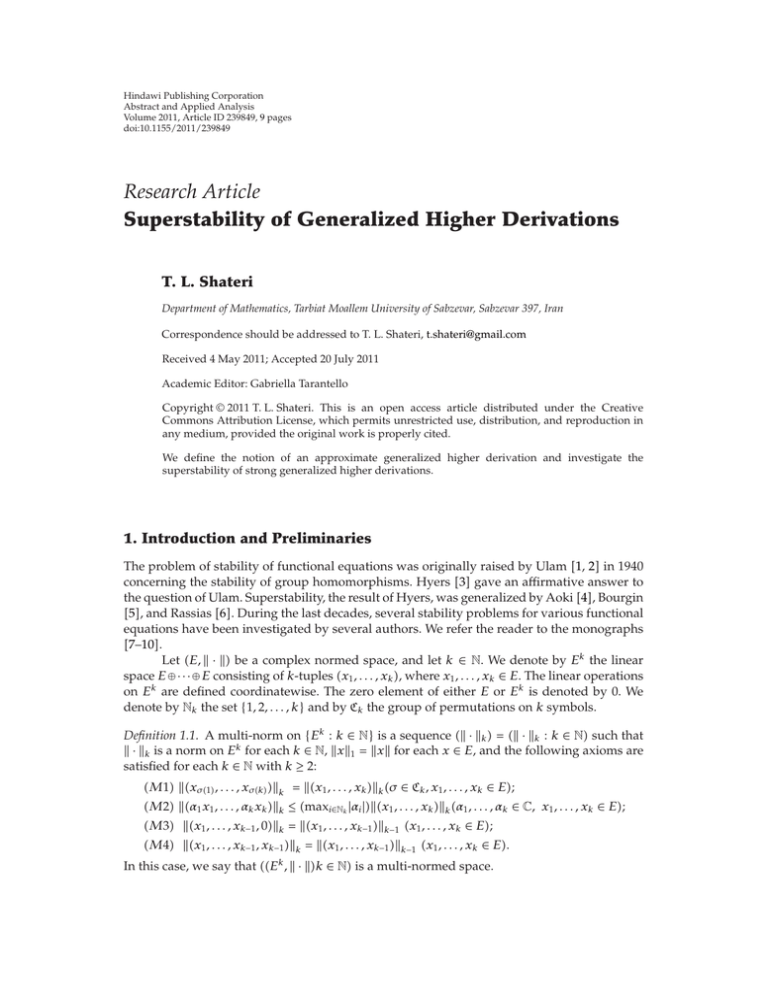
Hindawi Publishing Corporation
Abstract and Applied Analysis
Volume 2011, Article ID 239849, 9 pages
doi:10.1155/2011/239849
Research Article
Superstability of Generalized Higher Derivations
T. L. Shateri
Department of Mathematics, Tarbiat Moallem University of Sabzevar, Sabzevar 397, Iran
Correspondence should be addressed to T. L. Shateri, t.shateri@gmail.com
Received 4 May 2011; Accepted 20 July 2011
Academic Editor: Gabriella Tarantello
Copyright q 2011 T. L. Shateri. This is an open access article distributed under the Creative
Commons Attribution License, which permits unrestricted use, distribution, and reproduction in
any medium, provided the original work is properly cited.
We define the notion of an approximate generalized higher derivation and investigate the
superstability of strong generalized higher derivations.
1. Introduction and Preliminaries
The problem of stability of functional equations was originally raised by Ulam 1, 2 in 1940
concerning the stability of group homomorphisms. Hyers 3 gave an affirmative answer to
the question of Ulam. Superstability, the result of Hyers, was generalized by Aoki 4, Bourgin
5, and Rassias 6. During the last decades, several stability problems for various functional
equations have been investigated by several authors. We refer the reader to the monographs
7–10.
Let E, · be a complex normed space, and let k ∈ N. We denote by Ek the linear
space E ⊕ · · · ⊕ E consisting of k-tuples x1 , . . . , xk , where x1 , . . . , xk ∈ E. The linear operations
on Ek are defined coordinatewise. The zero element of either E or Ek is denoted by 0. We
denote by Nk the set {1, 2, . . . , k} and by Ck the group of permutations on k symbols.
Definition 1.1. A multi-norm on {Ek : k ∈ N} is a sequence · k · k : k ∈ N such that
· k is a norm on Ek for each k ∈ N, x1 x for each x ∈ E, and the following axioms are
satisfied for each k ∈ N with k ≥ 2:
M1 xσ1 , . . . , xσk k x1 , . . . , xk k σ ∈ Ck , x1 , . . . , xk ∈ E;
M2 α1 x1 , . . . , αk xk k ≤ maxi∈Nk |αi |x1 , . . . , xk k α1 , . . . , αk ∈ C, x1 , . . . , xk ∈ E;
M3 x1 , . . . , xk−1 , 0k x1 , . . . , xk−1 k−1 x1 , . . . , xk ∈ E;
M4 x1 , . . . , xk−1 , xk−1 k x1 , . . . , xk−1 k−1 x1 , . . . , xk ∈ E.
In this case, we say that Ek , · k ∈ N is a multi-normed space.
2
Abstract and Applied Analysis
We recall that the notion of multi-normed space was introduced by Dales and
Polyakov in 11. Motivations for the study of multi-normed spaces and many examples are
given in 11.
Suppose that Ek , · k k ∈ N is a multi-normed space, and k ∈ N. The following
properties are almost immediate consequences of the axioms:
i x, . . . , xk x x ∈ E;
ii maxi∈Nk xi ≤ x1 , . . . , xk k ≤
k
i1
xi ≤ k maxi∈Nk xi x1 , . . . , xk ∈ E.
It follows from ii that if E, · is a Banach space, then Ek , · k is a Banach space
for each k ∈ N. In this case, Ek , · k k ∈ N is a multi-Banach space.
By ii, we get the following lemma.
j
Lemma 1.2. Suppose that k ∈ N and x1 , . . . , xk ∈ Ek . For each j ∈ Nk , let {xn }n∈N be a sequence
j
in E such that limn → ∞ xn xj . Then for each y1 , . . . , yk ∈ Ek , one has
lim xn1 − y1 , . . . , xnk − yk x1 − y1 , . . . , xk − yk .
n→∞
1.1
Definition 1.3. Let Ek , · k k ∈ N be a multi-normed space. A sequence {xn } in E is a
multinull sequence if, for each > 0, there exists n0 ∈ N such that
supxn , . . . , xnk−1 k < n ≥ n0 .
k∈N
1.2
Let x ∈ E. We say that limn → ∞ xn x if {xn − x} is a multi-null sequence.
Definition 1.4. Let A, · be a normed algebra such that Ak , · k k ∈ N is said to be a
multi-normed space. Then Ak , · k k ∈ N is a multi-normed algebra if
x1 y1 , . . . , xk yk ≤ x1 , . . . , xk y1 , . . . , yk ,
1.3
k
k
k
for k ∈ N and x1 , . . . , xk , y1 , . . . , yk ∈ A. Furthermore, if Ak , · k k ∈ N is a multi-Banach
space, then Ak , · k k ∈ N is a multi-Banach algebra.
0
Let A be an algebra and k0 ∈ {0, 1, . . . , } ∪ {∞}. A family {Dj }kj0
of linear mappings
on A is said to be a higher derivation of rank k0 if the functional equation Dj xy j
i0 Di xDj−i y holds for all x, y ∈ A, j 0, 1, 2, . . . , k0 . If D0 idA , where idA is the
0
identity map on A, then D1 is a derivation and {Dj }kj0
is called a strong higher derivation.
0
, where D : A → A is a
A standard example of a higher derivation of rank k0 is {Dj /j!}kj0
derivation. The reader may find more information about higher derivations in 12–18.
0
of linear mappings on A is called a generalized strong higher derivation
A family {fj }kj0
0
such that
if f0 idA , and there exists a higher derivation {Dj }kj0
j
fj xy xfj y Di xfj−i y ,
i1
for all x, y ∈ A and j 0, 1, 2, . . . , k0 .
1.4
Abstract and Applied Analysis
3
The stability of derivations was studied by Park 19, 20. In this paper, using some
ideas from 21, 22, we investigate the superstability of generalized strong higher derivations
in multi-Banach algebras.
2. Stability of Generalized Higher Derivations
In this section, we define the notion of an approximate generalized higher derivation. Then
we show that an approximate generalized strong higher derivation on a multi-Banach algebra
is a strong generalized higher derivation.
Lemma 2.1. Let E, · be a normed space, and let F k , · k : k ∈ N be a multi-Banach space.
Let k ∈ N, > 0, and f : E → F a mapping satisfying f0 0 and
x1 y1
fx1 f y1
xk yk
fxk f yk
−
−
,...,f
−
−
sup f
≤ ,
t
t
t
t
t
t
k∈N
2.1
k
for all integer t > 1 and all x1 , . . . , xk , y1 , . . . , yk ∈ E, then there exists a unique additive mapping
T : E → F such that
fx1 − T x1 , . . . , fxk − T xk ≤ x1 , . . . , xk ∈ E.
2.2
Proof. Substituting yi 0 for i 1, . . . , k and replacing x1 , . . . , xk by tx1 , . . . , txk in 2.1, we
get
ftx1 ftxk ≤ .
fx
,
.
.
.
,
fx
sup
−
−
1
k
t
t
k
k∈N
2.3
Replacing x1 , . . . , xk by tn x1 , . . . , tn xk and dividing by tn in 2.3, it follows that
ftn x f tn1 x1 ftn xk f tn1 xk
1
sup
−
,
.
.
.
,
−
≤ n.
n
n
n1
n1
t
t
t
t
t
k∈N
k
2.4
An induction argument implies that
n
ft x1 ftnm x1 ftn xk ftnm xk ≤ 1 ··· 1
−
,
.
.
.
,
−
sup
,
tn
tnm
tn
tnm
tnm
tn1
k
k∈N
2.5
for x ∈ E and n, m ∈ N. Hence, the sequence {ftn x/tn } is cauchy and hence is convergent
in the complete multi-normed space F. Let T : E → F be the mapping defined by
ftn x
.
n→∞
tn
T x : lim
2.6
4
Abstract and Applied Analysis
Hence, for each r > 0, there exists N ∈ N such that
ftn x f tnk−1 xk
1
sup
− T x, . . . ,
−
T
x
≤ r n ≥ N.
n
nk−1
t
t
k∈N
2.7
k
In particular, the property ii of multi-norm implies that
n
ft x
0
lim −
T
x
n
n→∞
t
2.8
x ∈ E.
We show that T is additive. Putting n 0 in 2.5, we get
ftm x1 ftm xk ≤ .
fx
sup
,
.
.
.
,
fx
−
−
1
k
tm
tm
k
k∈N
2.9
Taking the limit as m → ∞, we obtain
sup fx1 − T x1 , . . . , fxk − T xk k ≤ .
k∈N
2.10
Let x, y ∈ E, put x1 · · · xk tn x, y1 · · · yk tn y in 2.1, and divide by tn , Then we
have
n n
n
f
t y ft
x
t x tn y
−n
−1
− t−1
−
t
≤ n.
t f
t
tn
tn t
2.11
k
By letting n → ∞, we get
xy
T
t
T x T y
.
t
t
2.12
Letting y 0 in 2.12 yields T x/t T x/t for all x ∈ E. Hence, we get T x y T x T y, that is, T is additive. Now, if T is another required additive mapping, we see
that
T x − T x ≤ 1 T tn x − T tn x
n
t
1
1
≤ n T tn x − ftn x n ftn x − T tn x
t
t
≤
2
tn−1 t
− 1
2.13
,
for all x ∈ E. By letting n → ∞ in this inequality, we conclude that T T . This proves the
uniqueness assertion.
Abstract and Applied Analysis
5
Definition 2.2. Let Ak , · k k ∈ N be a multi-Banach algebra. Suppose that > 0, t > 1 is
an integer and ψ : A × A → 0, ∞ is a control function such that
ψ tn x, tm y ≤ αnm ψ x, y ,
2.14
for some 0 < α < t, all nonnegative numbers m, n and all x, y ∈ A. An , ψ-approximate
0
of mappings from A into
generalized strong higher derivation of rank k0 is a family {fj }kj0
0
of mappings from A into A such
A with fj 0 0, f0 idA , and there exists a family {gj }kj0
that g0 idA and
fj x1 fj y1
x1 y1
z1 w1 −
−
− z1 fj w1 sup fj
t
t
t
k∈N
xk k1
zk wk
−gj z1 w1 , . . . , fj
t
fj xk fj yk
−
−
− zk fj wk − gj zk wk ≤ ,
t
t
2.15
k
for all 0 ≤ j ≤ k0 , t > 1 and all x1 , . . . , xk , y1 , . . . , yk , z1 , . . . , zk , w1 , . . . , wk ∈ A, and
j
fj xy − xfj y − gi xfj−i y ≤ ψ x, y ,
i1
2.16
for all 0 ≤ j ≤ k0 and x, y ∈ A.
0
Theorem 2.3. Let A be a Banach algebra with unit e, and let {fj }kj0
be a , ψ-approximate gener0
is a strong
alized strong higher derivation on a multi-Banach algebra Ak , · k k ∈ N, then {fj }kj0
higher derivation.
Proof. Letting zi wi 0 for i 1, . . . , k in 2.15, Lemma 2.1 implies that for each 0 ≤
j ≤ k0 , there is an additive mapping dj defined by dj x limn → ∞ fj tn x/tn such that
dj x − fj x ≤ for all x ∈ A. If j 1, 21, Theorem 2.2 implies that f1 and g1 are a
generalized derivation and a derivation, respectively. Also by the proof of 21, Theorem 2.2,
we have
f1 xy xf1 y g1 xy,
g1 tn x
d1 x − xd1 e g1 x.
n→∞
tn
lim
2.17
By induction for 1 ≤ i ≤ j − 1, assume that
i
fi xfi y gl xfi−l y ,
l1
gi i
gl xgi−l y ,
l0
2.18
6
Abstract and Applied Analysis
for all x, y ∈ A such that
i
gi tn x
d
gl xdi−l e gi x.
−
xd
−
x
e
i
i
n→∞
tn
l1
lim
2.19
It follows from 2.14 and 2.16 that
n n j
fj t2n xy
n gi tn x fj−i tn y α 2n
ψ t x, t y
≤
−
xf
y
−
≤
.
t
j
n
n
2n
2n
t
t
t
t
t
i1
2.20
Passing the limit as n → ∞, we obtain
lim y
n→∞
j−1
gj tn x
d
gi xdj−i y ,
xy
−
xd
y
−
j
j
tn
i1
2.21
for all x, y ∈ A. Put y e in the above equation, then
j−1
gj tn x
d
gi xdj−i e.
−
xd
−
x
e
j
j
n→∞
tn
i1
2.22
lim
If Dj x dj x − xdj e −
we get
j−1
i1
gi xdj−i e, then by additivity of di and gi for 0 ≤ i ≤ j − 1,
Dj a b dj a b − a bdj e −
j
gi a bdj−i e
i1
dj a dj b − adj e − bdj e −
j
gi adj−i e −
i1
j
gi bdj−i e
2.23
i1
Dj a Dj b.
j
Therefore, Dj is additive. Now, let Fx, y fj xy − xfj y − i1 gi xfj−i y, if we take
xi yi 0 and zi x, wi y for i 1, . . . , k in 2.15, then limn → ∞ Ftn x, y/tn 0. Hence,
fj tn xy
fj tn x · y
dj xy lim
lim
n→∞
n→∞
tn
tn
j
tn xfj y i1 gi tn xfj−i y F tn x, y
lim
n→∞
tn
j−1
xfj y gi xfj−i y Dj xy,
i1
2.24
Abstract and Applied Analysis
7
for all x, y ∈ A. Since g1 , . . . , gj−1 , f1 , . . . , fj−1 and Dj are additive, we can write
j−1
tn xfj y tn gi xfj−i y tn Dj xy
i1
dj tn x · y
dj x · tn y
2.25
j−1
xfj tn y tn gi xfj−i y tn Dj xy,
i1
for all x, y ∈ A. We conclude that xfj y xfj tn y/tn , so we can obtain xfj y xdj y,
for all x, y ∈ A as n → ∞. If x e, we have fj dj . Therefore,
j−1
fj xy xfj y gi xfj−i y Dj xy,
2.26
i1
for all x, y ∈ A. Now, we replace y by tn y in 2.16, then
n j
fj tn xy xfj tn y α n
ψ x, t y
≤
−
−
g
≤
,
y
xf
i
j−i
tn
tn
tn
t
i1
2.27
for all x, y ∈ A. We conclude that xfj y xfj tn y/tn , so we can obtain xfj y xdj y,
for all x, y ∈ A as n → ∞. If x e, we have fj dj . Therefore,
j−1
fj xy xfj y gi xfj−i y Dj xy,
2.28
i1
for all x, y ∈ A. Now, we replace y by tn y in 2.16, then
n j
fj tn xy xfj tn y α n
ψ x, t y
−
− gi xfj−i y ≤
≤
,
n
n
n
t
t
t
t
i1
2.29
for all x, y ∈ A. Letting n → ∞, we get
j
dj xy xdj y gi xfj−i y .
2.30
i1
Thus if y e, we conclude that
dj x xdj e j
i1
gi xfj−i e,
2.31
8
Abstract and Applied Analysis
for all x ∈ A. Hence,
gj x dj x − xdj e −
j−1
gi xfj−i e Dj x.
2.32
i1
But for all x, y ∈ A, we have
j−1
Dj xy fj xy − xyfj e − gi xy fj−i e
i1
j−1
j−1 i
gl xgi−l y fj−i e
xfj y gi xfj−i y Dj xy − xyfj e −
i1
g1 x fj−1 y − yfj−1 e −
j−1
gl y fj−l e
i1
l1
· · · gj−1 f1 y − yf1 e
l1
xDj y Dj xy j−1
gi xgj−i y ,
i1
2.33
j
and by 2.32, it follows that gj xy Dj xy i0 gi xgj−i y; therefore {gj } is a
strong higher derivation. By 2.28, we can conclude that {fj } is a generalized strong higher
derivation.
Remark 2.4. Recall that a control function is an operation that controls the recording or processing or transmission of interpretation of data. A typical example of the control function ψ
is ψx, y αxp yq δxp yq , such that , δ ≥ 0 and 0 ≤ p, q < 1.
Corollary 2.5. Every , ψ-approximate generalized derivation (regarded as an approximate generalized strong higher derivation of rank 1) on a multi-Banach algebra Ak , · k k ∈ N is a derivation.
The following theorem generalizes Theorem 2.3. The arguments are similar to those in
the proof of 21, Theorem 2.3.
0
0
be a family {fj }kj0
of mappings
Theorem 2.6. Let A be a Banach algebra with unit e, and let {fj }kj0
0
of mappings in
from A into A with fj 0 0 and f0 idA for which there exists a family {gj }kj0
which g0 idA on A such that
fj y1
fj x1 βx1 γy1
z1 w1 − β
−γ
− z1 fj w1 sup fj
t
t
t
k∈N
βxk γyk
− gj z1 w1 , . . . , fj
zk wk
t
fj xk fj yk
−β
−γ
− zk fj wk − gj zk wk ≤ ,
t
t
k
2.34
Abstract and Applied Analysis
9
for all 0 ≤ j ≤ k0 , t > 1 and all β, γ ∈ T {z ∈ C : |z| 1} and
j
fj xy − xfj y − gi xfj−i y ≤ ψ x, y ,
i1
2.35
0
for all 0 ≤ j ≤ k0 and x, y ∈ A, then {fj }kj0
is a strong higher derivation.
References
1 S. M. Ulam, A Collection of MathematicalProblems, Interscience Publishers, New York, NY, USA, 1960.
2 S. M. Ulam, Problems in Modern Mathematics, John Wiley & Sons, New York, NY, USA, 1964.
3 D. H. Hyers, “On the stability of the linear functional equation,” Proceedings of the National Academy of
Sciences of the United States of America, vol. 27, pp. 222–224, 1941.
4 T. Aoki, “On the stability of the linear transformation in Banach spaces,” Journal of the Mathematical
Society of Japan, vol. 2, pp. 64–66, 1950.
5 D. G. Bourgin, “Classes of transformations and bordering transformations,” Bulletin of the American
Mathematical Society, vol. 57, pp. 223–237, 1951.
6 T. M. Rassias, “On the stability of the linear mapping in Banach spaces,” Proceedings of the American
Mathematical Society, vol. 72, no. 2, pp. 297–300, 1978.
7 S. Czerwik, Stability of Functional Equations of Ulam—Hyers—Rassias Type, Hadronic Press, City, Fla,
USA, 2003.
8 D. H. Hyers, G. Isac, and T. M. Rassias, Stability of Functional Equations in Several Variables, Progress in
Nonlinear Differential Equations and their Applications, Birkhäuser, Boston, Mass, USA, 1998.
9 S.-M. Jung, Hyers-Ulam-Rassias Stability of Functional Equations in Mathematical Analysis, Hadronic
Press, Palm Harbor, Fal, USA, 2001.
10 T. M. Rassias, Functional Equations, Inequalities and Applications, Kluwer Academic, Dodrecht, The
Netherlands, 2003.
11 H. G. Dales and M. E. Polyakov, “Multi-normed spaces and multi-Banach algebras,” preprint.
12 P. E. Bland, “Higher derivations on rings and modules,” International Journal of Mathematics and
Mathematical Sciences, no. 15, pp. 2373–2387, 2005.
13 H. Hasse and F. K. Schmidt, “Noch eine Begrüdung der theorie der höheren differential quotienten
in einem algebraischen funtionenkörper einer unbestimmeten,” Journal für die Reine und Angewandte
Mathematik, vol. 177, pp. 215–237, 1937.
14 S. Hejazian and T. L. Shatery, “Automatic continuity of higher derivations on JB ∗ -algebras,” Bulletin
of the Iranian Mathematical Society, vol. 33, no. 1, pp. 11–23, 2007.
15 S. Hejazian and T. L. Shatery, “Higher derivations on Banach algebras,” Journal of Analysis and
Applications, vol. 6, no. 1, pp. 1–15, 2008.
16 S. Hejazian and T. L. Shateri, “A characterization of Higher derivations ,” submitted to Italian Journal
of Pure and Applied Mathematics.
17 N. P. Jewell, “Continuity of module and higher derivations,” Pacific Journal of Mathematics, vol. 68, no.
1, pp. 91–98, 1977.
18 Y. Uchino and T. Satoh, “Function field modular forms and higher-derivations,” Mathematische
Annalen, vol. 311, no. 3, pp. 439–466, 1998.
19 C.-G. Park, “Linear derivations on Banach algebras,” Nonlinear Functional Analysis and Applications,
vol. 9, no. 3, pp. 359–368, 2004.
20 C.-G. Park, “Lie ∗ -homomorphisms between Lie C∗ -algebras and Lie ∗ -derivations on Lie C∗ algebras,” Journal of Mathematical Analysis and Applications, vol. 293, no. 2, pp. 419–434, 2004.
21 S.-Y. Kang and I.-S. Chang, “Approximation of generalized left derivations,” Abstract and Applied
Analysis, Article ID 915292, 8 pages, 2008.
22 M. S. Moslehian, “Superstability of higher derivations in multi-Banach algebras,” Tamsui Oxford
Journal of Mathematical Sciences, vol. 24, no. 4, pp. 417–427, 2008.
Advances in
Operations Research
Hindawi Publishing Corporation
http://www.hindawi.com
Volume 2014
Advances in
Decision Sciences
Hindawi Publishing Corporation
http://www.hindawi.com
Volume 2014
Mathematical Problems
in Engineering
Hindawi Publishing Corporation
http://www.hindawi.com
Volume 2014
Journal of
Algebra
Hindawi Publishing Corporation
http://www.hindawi.com
Probability and Statistics
Volume 2014
The Scientific
World Journal
Hindawi Publishing Corporation
http://www.hindawi.com
Hindawi Publishing Corporation
http://www.hindawi.com
Volume 2014
International Journal of
Differential Equations
Hindawi Publishing Corporation
http://www.hindawi.com
Volume 2014
Volume 2014
Submit your manuscripts at
http://www.hindawi.com
International Journal of
Advances in
Combinatorics
Hindawi Publishing Corporation
http://www.hindawi.com
Mathematical Physics
Hindawi Publishing Corporation
http://www.hindawi.com
Volume 2014
Journal of
Complex Analysis
Hindawi Publishing Corporation
http://www.hindawi.com
Volume 2014
International
Journal of
Mathematics and
Mathematical
Sciences
Journal of
Hindawi Publishing Corporation
http://www.hindawi.com
Stochastic Analysis
Abstract and
Applied Analysis
Hindawi Publishing Corporation
http://www.hindawi.com
Hindawi Publishing Corporation
http://www.hindawi.com
International Journal of
Mathematics
Volume 2014
Volume 2014
Discrete Dynamics in
Nature and Society
Volume 2014
Volume 2014
Journal of
Journal of
Discrete Mathematics
Journal of
Volume 2014
Hindawi Publishing Corporation
http://www.hindawi.com
Applied Mathematics
Journal of
Function Spaces
Hindawi Publishing Corporation
http://www.hindawi.com
Volume 2014
Hindawi Publishing Corporation
http://www.hindawi.com
Volume 2014
Hindawi Publishing Corporation
http://www.hindawi.com
Volume 2014
Optimization
Hindawi Publishing Corporation
http://www.hindawi.com
Volume 2014
Hindawi Publishing Corporation
http://www.hindawi.com
Volume 2014

